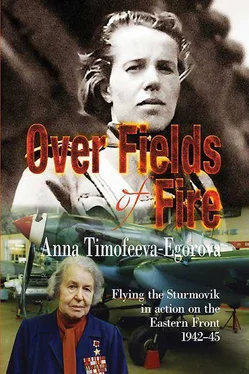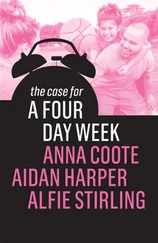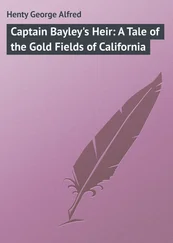“Double-quick to the plane!” the captain ordered, and at that I ran. The plane mechanic Vasya Rimskiy checked off to me the machine’s readiness. Putting on the parachute I climbed into the cockpit, buckled on the belts, tuned up the two-way for reception, checked everything off as we’d been trained and turned the engine on.
The sensation of take-off, the disappearance of your firm foothold, is amazing. The plane is still running across the rough field gaining speed, one more instant — and it detaches from the ground and the pilot is now carried on two steel wings. During the first circular flight I’d noticed how much faster this traditional route of four turns was completed — the U-2’s engine was no match for the Il-2’s. I had estimated the landing run precisely and landed exactly by the ‘T’-junction: as pilots say, ‘on three points’.
You wouldn’t wish a better one! I taxied out and saw the captain showing me with his arms: ‘do one more flight’. So I rolled for another take-off. Our aerodrome was situated almost on the shore of the Azov Sea, so during flying most of the route was made over the water. I couldn’t swim and was afraid of water. Once in my childhood I nearly drowned: my mum was rinsing the washing, I was with her and fell into the water. I still feared water and swam only close to the shore. And here, after take-off there was a turn over the waves, a second, a third, a fourth one — all over the sea, and then I would land on the aerodrome. And doing a turn over the water I heard a backfire resound, then another — and the engine stalled. The prop stopped, a sinister silence descended…
I automatically pushed the control column away and switched the plane to gliding — so as not to lose speed and not to fall into the sea with the Sturmovik . After that I continued doing everything according to instructions: I throttled back, turned off the ignition, closed the fuel emergency shutoff cock. In a word, I set everything in the cabin on ‘economy’. The aerodrome was already right in front of me, and all would have been alright, but the speed and altitude were falling catastrophically fast. I quickly understood that I wouldn’t make it to the aerodrome and would have to land right in front of my nose. But what was that? The whole terrain was pitted by deep ravines! If I landed on them I would be done for! And at the same time I heard the anxious voice of the regimental commander Kozin in the radio: “What’s happened? What’s happened? Receiving!” But I couldn’t reply for I had no transmitter. And I had no time for replying — all my attention was fixed on the ground. I noticed a narrow strip of flat ground between two ravines and decided to land on it, opened up the cockpit for a better field of vision, then lowered the undercarriage…
Needless to say, the time dragged agonizingly slowly. Then the machine touched down, rolled forward and I did my best to hold her and not to let her fall into a ravine. To achieve that I was energetically ‘pumping’ — pushing the brakes with my feet — and the speed began to fall bit by bit, the wings to lower steadily, and the plane slowed down and stopped. And when I, wet all over, leaped out of the cockpit onto a wing and looked down I saw with horror that my machine’s wheels had stopped right on the edge of a ravine. Numerous skeletons of dead animals lay at the bottom…
I examined the plane — it seemed unscathed. Everything seemed to be in place, and in one piece, except a bail was cracked slightly and a wing was damaged. And there were many patches on the wings and the fuselage as well — the ‘Il’ was riddled all over. The poor Ilyushin had been through a lot during the recent fighting near Ordzhonikidze! It had put its life on the line defending the approaches to Transcaucasia, to the oil-rich districts of Grozny and Baku. The engine must have been through a lot as well — and now it had succumbed. I knew in combat a plane engine was supposed to experience heavy overload, overstrain, and begin to play up by the end of its lifetime. But what had actually happened to it? Why had it stalled? There still was fuel, and oil too. True, some of the devices controlling its work had conked out. But I didn’t want to blame anyone and had nothing against anyone. I understood that during combat a pilot sometimes had to rev up sharply, boost and sharply decelerate, dive at high revs, gain altitude, without sparing the engine. But it had stalled now when I was flying straight, at the assigned altitude, at the defined speed and revolution rate, when I was watching the gauge readings maintaining the most suitable operating conditions for the engine. Basically, I wasn’t overburdening her but she had still stalled… I knew that as soon as we — the young pilots — had mastered our Il-2s completely, they would be written off and we would go to a plant to receive new ones. But that didn’t make me feel any better.
Standing on the spot and pondering it over, I suddenly noticed an ambulance rushing and the pilots running across the field towards me. “Well, — I thought, — I’ll get it now!” And would you believe who was the first to run up to me? The very same trainer from school who had unfairly given me just a ‘good’ mark for a problem I’d been the first to solve! Then, having left the vehicle, out of breath, Doctor Kozlovskiy appeared with his first-aid kit on him. Finding me in one piece and unharmed he began to wail, wiping off sweat and tears from his wrinkled face, “My sweetheart, you’re safe! I’m so glad!”
The regimental commander, who would also fly with us to get a plane (the whole regiment flew) then told me: “Anna Alexandrovna”, now for the first time he called me by my name and patronymic, “you’ve done well, you saved the plane. Whatever is damaged the mechanics will fix up in no time, grease up the percale, put on a lick of paint and it’ll be alright — we’ll fly again!”
By evening the Sturmovik ’s engine had been examined, repaired and tested. They turned the plane away from the ravine towards the sea and Captain Karev (being the most experienced pilot of the regiment) took off and safely landed at the aerodrome. And the next day after these events all the personnel of our unit were lined up. No one knew for what reason it had been done but suddenly I heard the following: ‘Junior Lieutenant Egorova, step forward!”
My new comrades moved aside letting me forward from the rear row. I hesitantly stepped out of the line and stood to attention: “What’s going to happen? Will they ascribe the fault for the forced landing to me? I’m going to get it in the neck! They’ll say, ‘she can’t handle the engine’. How will I prove it wasn’t my fault?”
And suddenly the regiment commander said ceremoniously: “For the excellent sortie in the Il-2 plane and salvation of the fighting equipment entrusted to you I express my gratitude!”
“I serve the Soviet Union!” I responded with breaking voice after a long pause.
After this incident attitudes toward me in the regiment changed abruptly…
21. Dropping bombs through a ‘bast-shoe’
Now the training flights began: each time more and more complex and crucial — flying in the zone, bombing, shooting. We had our own firing range in the mountains in a desolate area. There were dummy tanks, guns, railway cars, planes with white-cross markings — they served us as targets for drill attacks. How many times, having gained altitude, I threw the Sturmovik
into a steep dive, pressed all the triggers and fiercely attacked the targets! Then our group set about flying in a pair, a flight, a squadron. As I said before, Valentin Vakhramov and I had been assigned to the 3rd Squadron. Its commander, Lieutenant Andrianov, having listened to us report for duty, stood silent for quite a while, puffing on a pipe with a long stem. From the first encounter I remembered him like that: tall, dark-eyed, with weather-beaten face, in a black leather raglan, a red-topped black kubanka 102 102 Translator’s note — a smaller variety of astrakhan — originally from the Kuban Cossack province.
tilted onto his eyebrows. Andrianov’s raglan was girdled by a wide officer’s belt with a holster on it holding a pistol, and on another, narrow, belt slung across his shoulder, hung a map in a mapcase. And it didn’t just hang — it hung with style, nearly touching the ground. All his looks and bearing said: “I’m not a boy any more, I’m a seasoned comesk even if no older than you in years”.
Читать дальше












